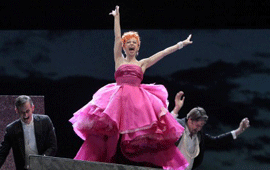> [Archived] Chronicles

Violetta, a different character - Natalie Dessay in the new La Traviata at the Vienna State Opera
At the Theatre on the Ring, the 2011-2012 opening season brought a new La Traviata, directed by the Frenchman Jean-François Sivadier (opening night: October 9th). Reviews were mostly negative than positive, especially about the direction, and the public's acceptance was cold, if we do not consider the ovations for the soprano Natalie Dessay (Violetta) and the baritone Fabio Capitanucci (Giorgio Germont), the latter being also the only one who ran the gauntlet of criticism without any scratches. The bass Dan Paul Dumitrescu was also appreciated in the role of Dottore Grenvil. The Romanian bass honourably fulfilled this part of 'true friend' to Violetta, which brought him in the foreground in key moments of the action.
Which is more conservative: the audience or the reviewer?
I watched the fifth re-run of the show in Friday, October 21st, but I am not among those disappointed by the direction or the soloists. It is true that I am not one of those experts who hunt the acute sounds in cabalettas, nor do I miss the useless fanciness in the direction of masterpieces. From my perspective, Sivadier directed La Ttraviatta with a respect for the music. He quietly did his job: he built up dramatic climaxes, he emphasised the action and the characters, he gambled - naturally - on the intensity of the expression and on the dramatic play. He thus dared a modern enactment of which the music reviewers do not seem to be aware of, but even so, I am not sure which is more conservative: the audience or the reviewer?
The discrete modernity of Sivadier's La Traviatta lies in the courage to present a different Violetta character than the one known through the great artists of the past. Incidentally, there are photos in the playbill of Maria Cebotari [1940], Ileana Cotrubaº [1971] and Angela Gheorghiu [1995], together with Elisabeth Schwarzkopf and Anna Netrebko as references for interpreting Violetta at the Vienna State Opera. But the recent staging does not look towards these models, but revolves around the character created by and for Natalie Dessay, highlighted by the conductor Bertrand de Billy. De Billy studied the original score, worked together with the instrumentalists so as to cut out 'false traditions and performing habitualness' (quote from the programme notebook, p.9); requested more nuanced shades and paid more attention to solo instruments.
Modern simplicity vs. Convenient pattern
Thus was created, from the orchestra's pit, the requirements for Natalie Dessay's success: a natural Violetta, anti-diva, but an artist in the true sense of the word. Imagine a Violetta without any glamour and erotic charm, as simple as a Cosette with no luck, with direct gestures, a little clumsy. The delicate, non-conventional Natalie Dessay opposes the clichés fed over the years of Violettas glamorous and with sex appeal even on the brink of death. She casts a new light on the character, she unravels the outer layers of the woman she embodies and is not afraid to be ugly in the face of sickness, pain or death. Highly expressive, the soprano obviously understood her part. I think she also understood it because of her collaborators, who had the courage to break the convenient patterns, unfortunately still dominant in performing works from the 19thcentury.
Translated by Florina Sãmulescu and Elena Daniela Radu
MTTLC, Bucharest University














